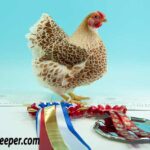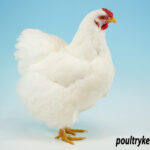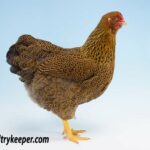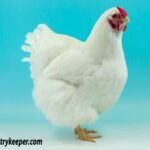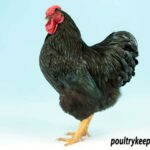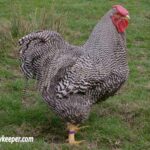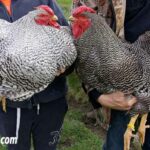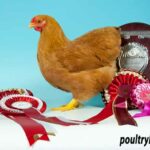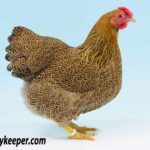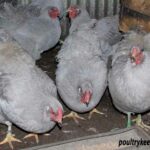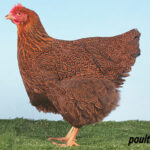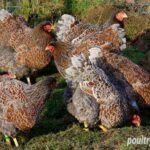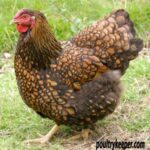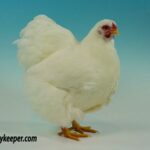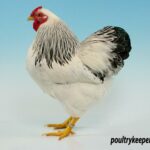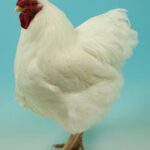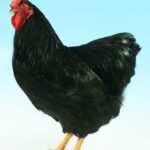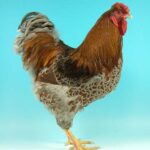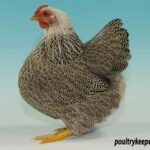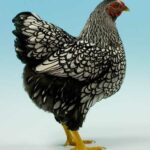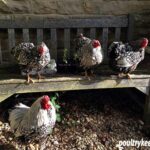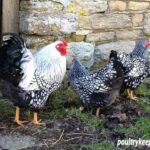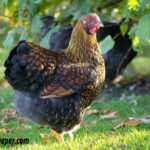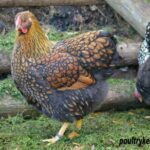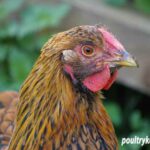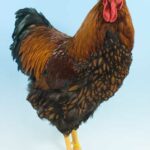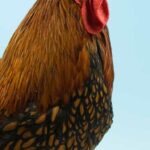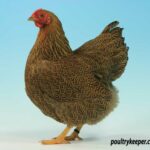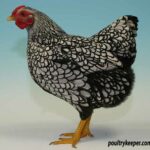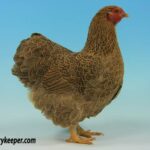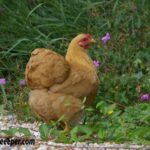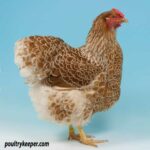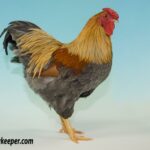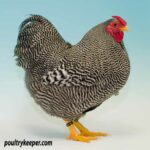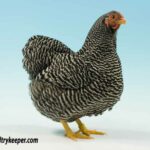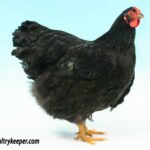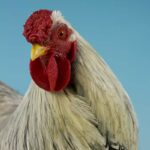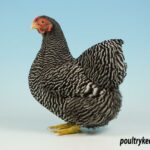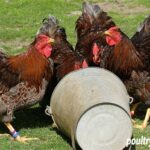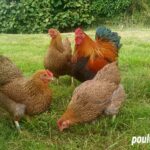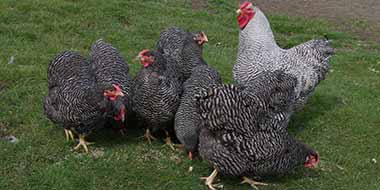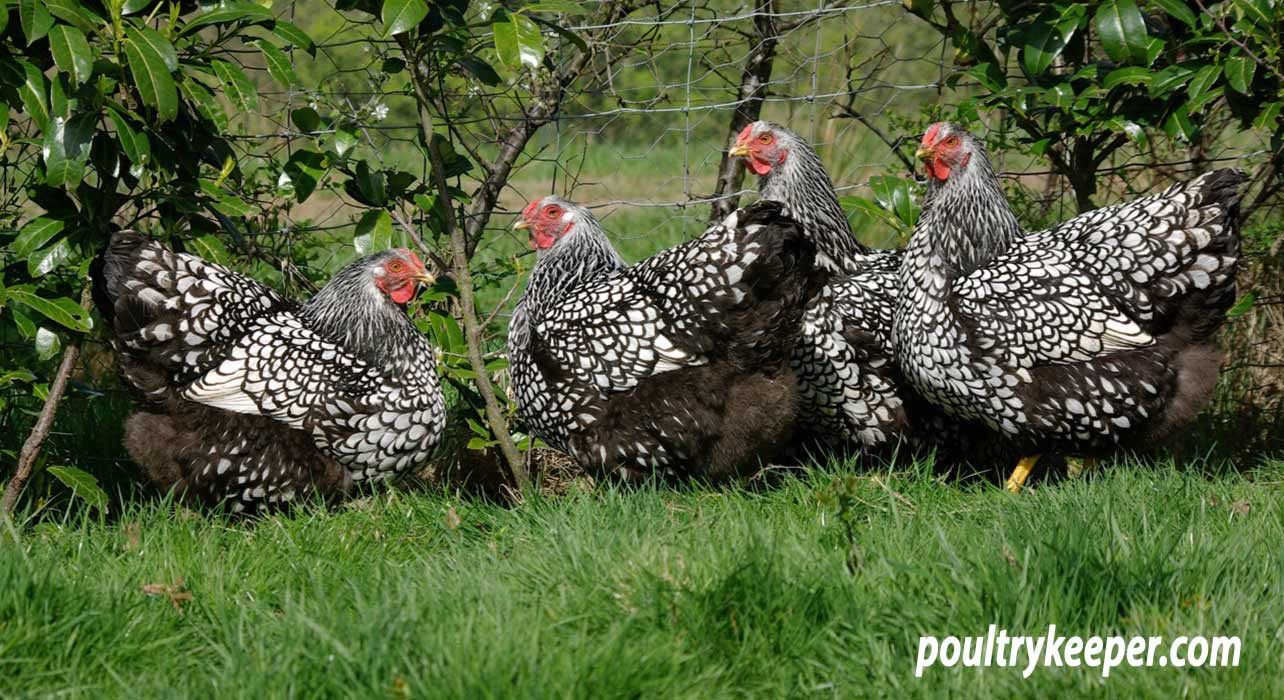
Breed In
Focus
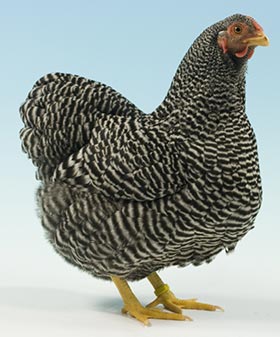
Wyandotte chickens have no less than 13 standardised colour varieties in the British Poultry Standards and boasts the most clubs of any poultry breed.
Generally calm in nature and good egg producers, the Wyandotte is a popular choice for the back garden, however, a lot of skill is required to breed some of the colour varieties making it an interesting challenge to exhibit.
The Wyandotte breed was always going to be created – it was just a matter of time! In the 1870s, several north-western American farmers had visualised a dual-purpose fowl that would proudly display the laced pattern of the Sebright bantam. They generally accepted that the breed would be rose-combed, to avoid problems with frostbite in their long and cold winters (as can be the case with large single comb breeds like Leghorns), clean-legged (with no feathers on the legs) and yellow-skinned (the preferred variety for American table birds).
Several strains of prototype Wyandottes were in development, using a variety of breeds. These were called many things: American Seabrights (note the spelling), Seabright Cochins, Eurekas, Hambletonians, Hambrights, Oneidas, Excelsiors and Sebright Brahmas, to name but a few.
In 1877, the American Poultry Association (APA) held a meeting at Buffalo, at which many breeders tried to get their respective laced varieties standardised. Prominent amongst those present were a Mr Kidder, a Mr Payne and a Mr Whittaker. The APA wisely told them to go away and sort themselves out, as they would only standardise one laced breed.
Where did Wyandotte come from?
The name 'Wyandotte' was suggested by a Mr Fred Houdlette, from Waltham, Massachusetts, and named after a tribe of North American Indians. It was also the name of a ship owned by Fred's father. But these 'Silver Laced Wyandottes' were not as we see and adore today - initially, they had black feathers with small patches of white in the centre.
Shortly after standardisation, a breeder sent some stock to England to a Mr J Pilling of Chester. The first UK exhibiter of Silver Laced Wyandottes was a Mr Tom Heath at the 1884 Staffordshire show.
Coming back to the present day for a moment…
For almost 20 years, I’d heard about how Laced Wyandotte Club Member, Margot Haines (formerly Spencer), had a Silver Laced male in a display case that was from the original strain imported into this country in the 1880s. So, when the invitation came from UK Club Secretary Trefor Griffith to accompany him on a trip to collect ‘The Old Gentleman’ – as the taxidermied piece is affectionately known – one could hardly resist!
And it was thought [by many] that Margot’s Grandfather, Richard Fred Spencer, imported the original Silver Laced Wyandottes into the country.
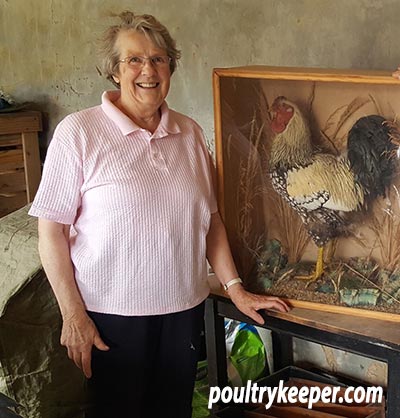
Still, Margot clarified that the ‘immortal’ winner was the Grandson of a bird rented by her Grandfather… “It’s what you did in those days!” and that while it was from the original US strain, it was likely a good friend of Mr Spencer, a Mr Fred Houdlette, who did the importing and visited the Spencer farm often. William Allan Spencer, Margot’s Great Uncle, took up Laced Wyandottes in 1886 and partnered with his brother, Richard (a successful partnership that would last over 40 years).
Showing birds was intense in those days, and the strain hadn’t long been over from America – only about three years. In 1900, Richard, a journalist by trade, published his book Wyandottes and All About Them. A second edition was subsequently published in 1910. It was acknowledged at the time that the Spencers greatly improved the lacing of the Silver Laced Wyandotte.
The ‘stuffed bird’ (1895), as Margot puts it, was bred in 1890. The story goes… The Grandfather of the bird was bred by a Mr Walter Beeson of Oxford and purchased by another fancier who wouldn’t sell it, so Margot’s Great Uncle and Grandfather rented the bird for quite a lot of money once the breeding season was over. They had the bird for about a year and bred a cockerel that went on to produce ‘The Old Gentleman’ in 1890. With this cock and his descendants, they won the ‘North of England Wyandotte Fanciers Association Challenge Cup for Silver Laced Wyandotte Cock’ five years in succession, the Old Gent winning it in 1892, 1893 and 1894, at which point the trophy was retained by the Spencer family. Margot laughed and said: “My Mother cleaned it for 50 years!”
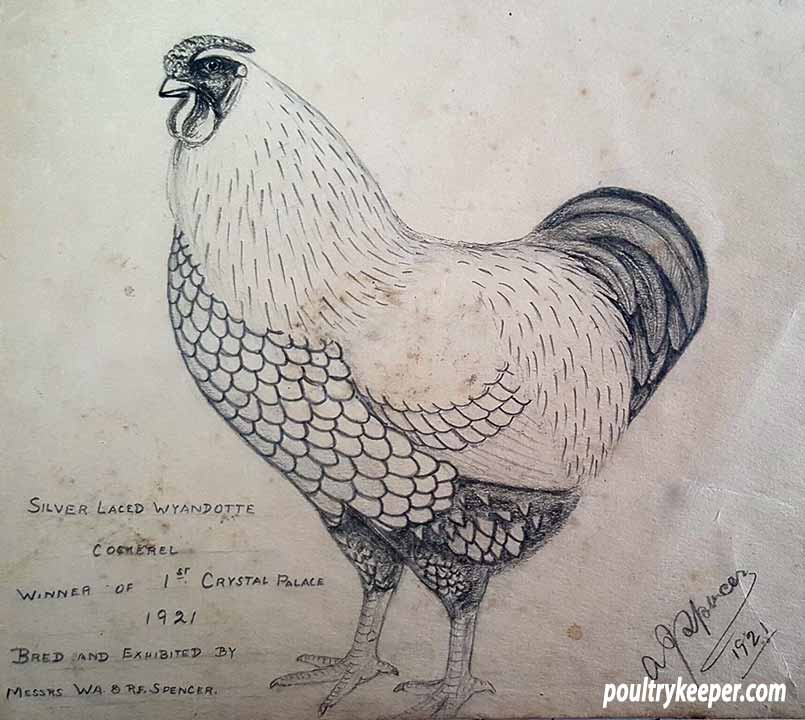
White Wyandottes
According to the history books, White Wyandottes first emerged as sports from Silver Laced breeding pens, which is difficult to imagine when you consider that they are so fluffy and feathery in comparison to all of the other Wyandotte varieties.
They were first standardised in America in 1888. The early Whites weren’t snow-white, like today’s show exhibits – they were usually found with black specks on their white feathers, and the males were brassy. In the eastern states of America, they were bred primarily for meat, whereas in the UK, they were regarded as good egg layers, with some strains believed to have been crossed to White Leghorns to really enhance commercial success. This is believable because the old ‘utility’ Whites were nothing like exhibition Wyandottes in so far as shape; they were virtually rose-combed Leghorns.
Clem Shaw from Shropshire had the most impressive utility strain of White Wyandottes. Today’s show specimens are greeted with awe and a certain degree of criticism by those who deem them ‘too fluffy!’ This is somewhat justified, especially when you consider that White Wyandottes have been used to help bring more feather to strains of both large fowl and bantam White Orpingtons.
However, a well-put-down White Wyandotte is a sight to behold, and both the large fowl and bantams have been the recipients of some highly contested awards in recent years, including best in show at the National shows.
When you have a snow-white plumage, complemented by yellow legs and red face, on a shapely and fit bird, it takes some beating – they really do stand out. And we should remember that whilst some folk accuse the Whites of being too fluffy, specimens range in shape between strains and breeders and that Whites are often the ‘go-to’ colour to improve the type of other varieties.
There may be some ‘over fluffy’ examples, but generally, the Whites represent the best type of the Wyandotte breed.
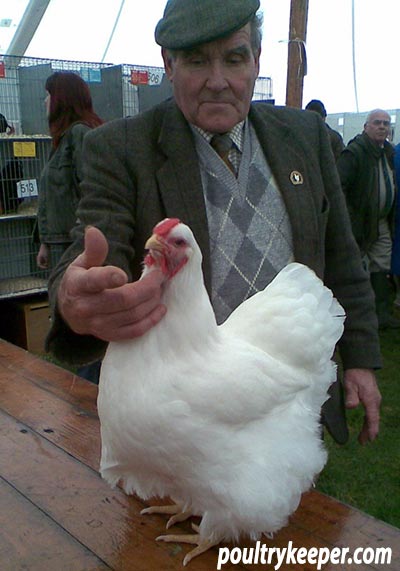
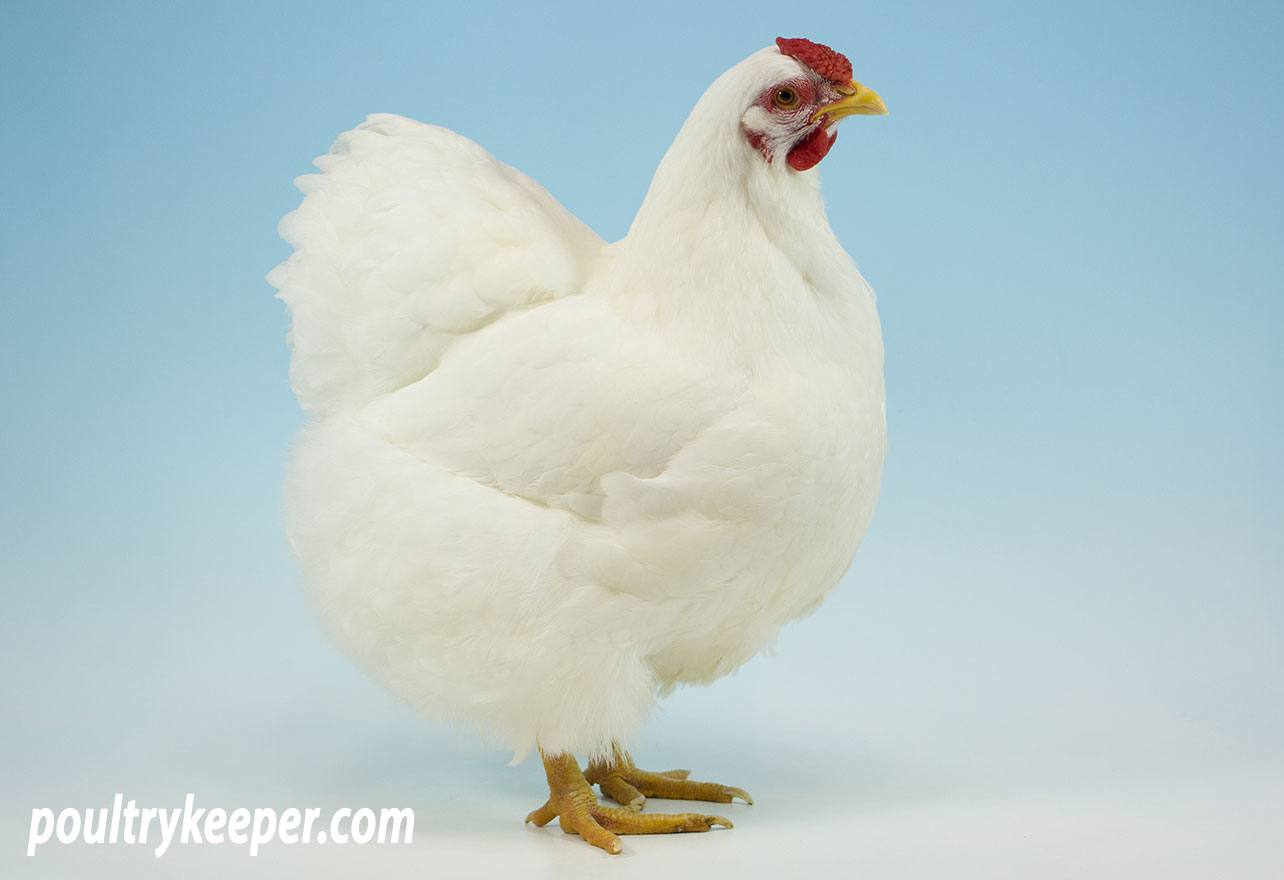
Gold Laced Wyandottes
Gold(en) Laced Wyandottes were created in the 1880s in Wisconsin, USA, by a breeder called Joseph McKeen, who, by chance, developed his strain of yellow-coloured birds that displayed varying amounts of black lacing.
They were a blend of Partridge and Buff Cochins, rose-combed Leghorns and Gold Sebrights. At the time, he lived on a farm called Winnebago Poultry Farm. Hence the name Winnebagoes, which, through further breeding and crosses to Silver Laced Wyandottes, later became Gold(en) Laced Wyandottes. They were admitted to the American Standard of Perfection in 1888.
The original Gold Laced Wyandottes arrived on British shores through an importer and exhibitor called Mr A. W. Geffcken, who bred and exhibited them with much success.
In recent years, however (the mid-90s onwards), the Gold Laced Wyandottes have been the subject of much debate in the Laced Wyandotte Club because the desire for perfect lacing has resulted in different breeding directions for exhibition males and females; the males generally being lighter in ground colour than their female counterparts. Eventually, around 2010, the club voted unanimously to settle on the [in between] tone of chestnut brown.
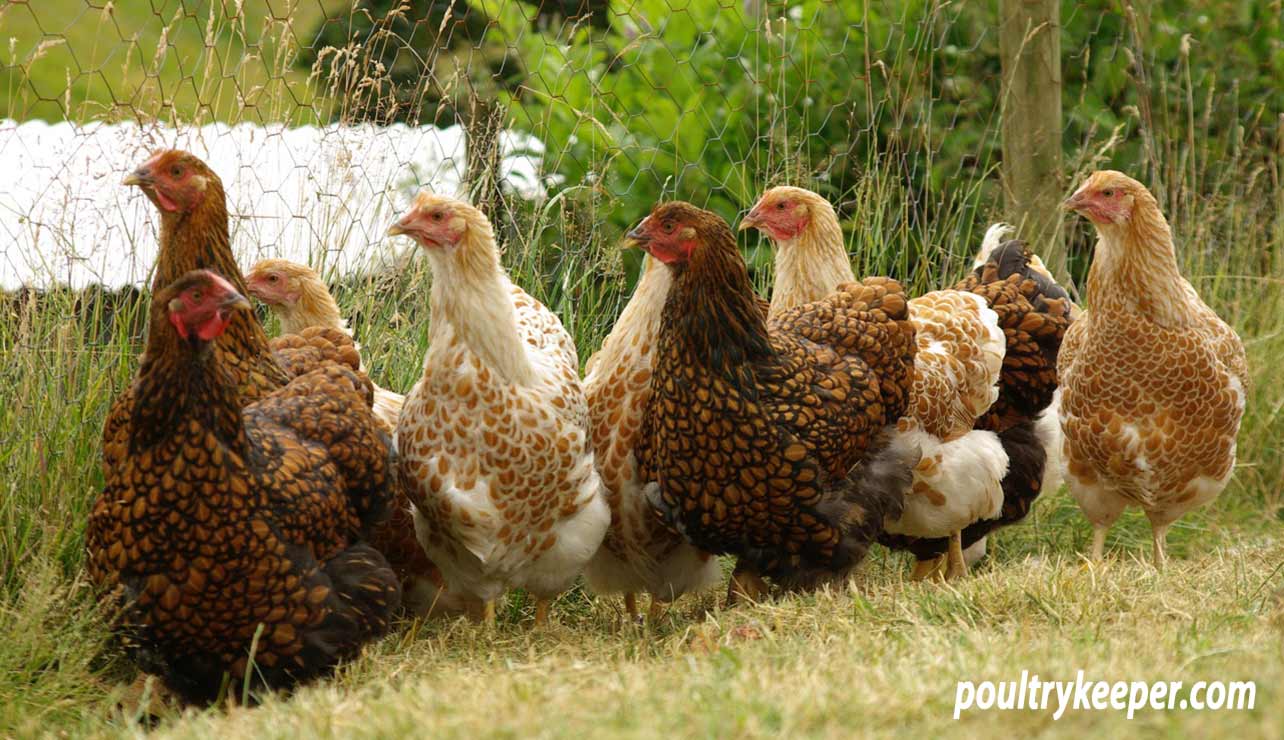
Blue Laced Wyandottes
The original Blue Laced Wyandottes were referred to as Violets or Violet Laced and were developed in America in the late 1800s. Their existence is credited to a Mr Pond and Mr Brackenbury, who began crossing Golden Laced Wyandottes, Buff Cochins and Andalusian hens. Rev. John Crombleholme, of Accrington, Lancashire, imported stock to British shores in 1897, which attracted a brief interest here.
A Blue Laced Wyandotte Club was in existence between 1905-1910, but the variety soon became rare. Some early records indicate that Blue Laced Wyandottes were shown here in the 1920s but by then may have derived from Dutch or German imports, as were the ones that fanciers showed in the UK from the 1960s onwards. The Blue Laced bantams we see at shows today likely stem from imported German stock in the 1990s, and undoubtedly the large Blue Laced derive from several German imports over the last two decades.
The blue gene
Unfortunately, the Blue Laced Wyandottes don’t breed true. This is a real novelty for some people, but others find it off-putting. The reason for the predictable variability in offspring is the blue gene and how it is inherited.
Breeding Blue Wyandottes
From a pair of Blue Laced breeding birds, you can reasonably expect to get around half that resemble their parents, one-quarter Buff Laced (mahogany with white lacing) and one-quarter Gold Laced (mahogany with black lacing).
Sadly, the Blue Laced effect (as with any blue chickens) is possible by the fowl in question only carrying a single dose of the blue gene. Still, chickens can carry up to two copies of said gene, and in such specimens dilutes the lacing further to a white colour.
You might regard this as Double-Blue Laced, and it didn’t take people long to figure out that breeding the Buff Laced to Gold Laced (from Blue Laced parents) produces all Blue Laced offspring, but it works much better aesthetically if the birds are from a highly selected strain.
If things weren’t complicated enough, the two off-colours from a Blue Laced pen (Buff Laced and Gold Laced) are very similar to separate lines of the same names with precise standards in the exhibition world.
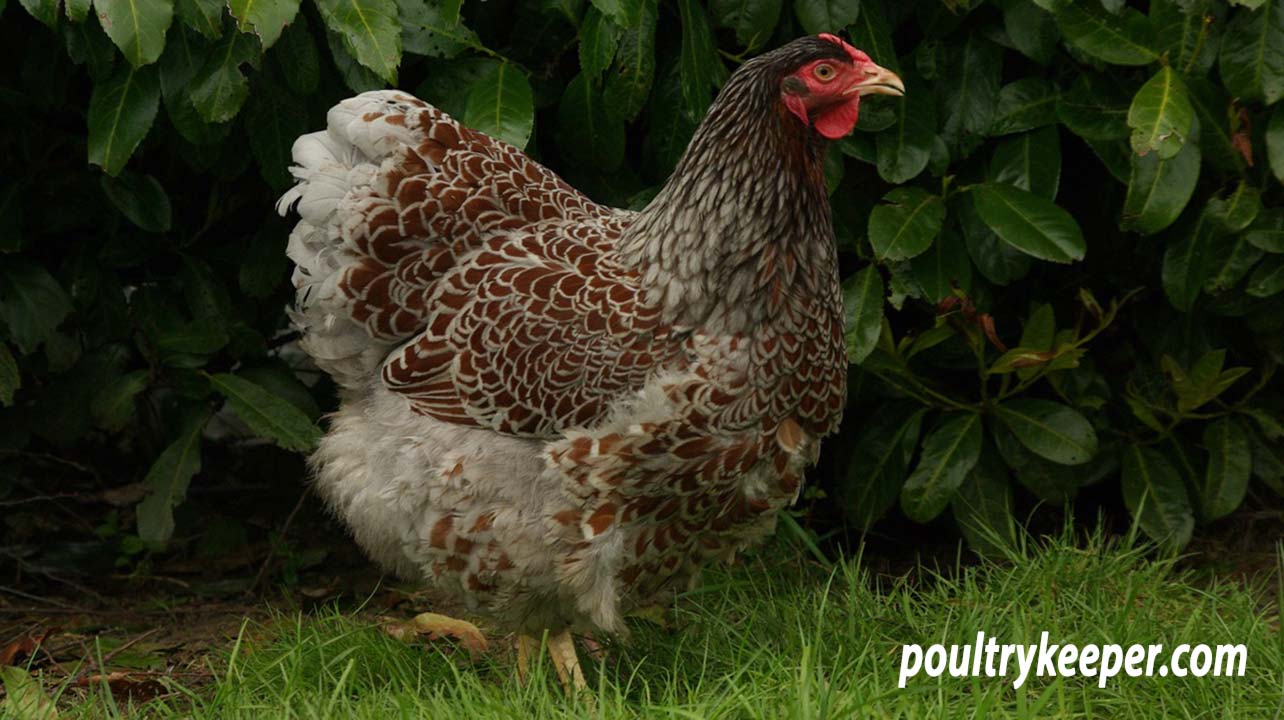
The exhibition Gold Laced tend to be more of a chestnut plumage as opposed to the mahogany of the Gold Laced that come from Blue Laced. Exhibition Buff Laced (lighter in body colour) has a different genetic make-up to the Buff Laced that emerge from Blue Laced, which tend to have blue splashes in their white lacing and display a bluish tinge on some specimens.
To delineate the differences, I coined the unofficial term ‘Splash Laced’ to describe birds that came from a Blue Laced pen – as the word ‘splash’ in poultry means ‘double blue.’ But it is important to note that all offspring from a Blue Laced pen are beautiful, no matter how you refer to them.
They certainly have been there to bolster the numbers at shows when the ‘proper’ types of Buff Laced were short in numbers, and have also been invaluable as outcrosses to regenerate the exhibition Gold Laced and Buff Laced Wyandottes.
Exhibition Buff Laced Wyandottes
Some people refer to this type of Buff Laced as the ‘proper type’, leading to confusion. Generally, they are lighter in ground colour shade to the similar variety that comes from Blue Laced parentage (who are very mahogany in ground colour).
A rule of thumb is that this type of Buff Laced has no Blue Laced breeding in its ancestry. The ‘white’ lacing (in this type) is caused by another factor – known as the dominant white gene (interestingly, this is the same gene that accounts for the white parts of Warren Brown or Lohman Brown hybrid layers, as well as pure breeds such as Pile Game).
Sadly, it means that any Buff Laced stock made this way rarely breeds true. Breeders often report that you get only about half of the offspring looking like their parents, with the remainder split between Gold Laced or virtually completely white birds (very washed out Buff Laced at the very least).
So you can see how very confusing it all is. Newcomers get frustrated that they can’t show the Gold Laced that emerge from either their Blue Laced or Buff Laced exhibition stock and sometimes they can get away with it (largely dependant on how dark the parent strain is).
Origins
The first Buff Laced’ were seen in America in 1886 and are credited to a Mr Ira C. Keller of Ohio. These were created by crossing Gold Laced to White Wyandottes that had emerged as sports from Silver Laced Wyandottes, similar to how an entirely British strain was made in Cornwall in the 1970s by the late Gilbert May and his father-in-law Harry Thomas. Their Gold Laced cockerel had jumped a fence and got in with their White Wyandottes. The daughters from the accidental mating were rather beautiful, and Harry and Gilbert saw the potential of crossing them back to their Gold Laced’ to keep the white gene but purify the lacing. They did this very successfully and exhibited them for many years.
My original large fowl Buff Laced Wyandottes came from Gilbert at the Federation show (circa 2000), transported in the luggage compartment of a large coach.
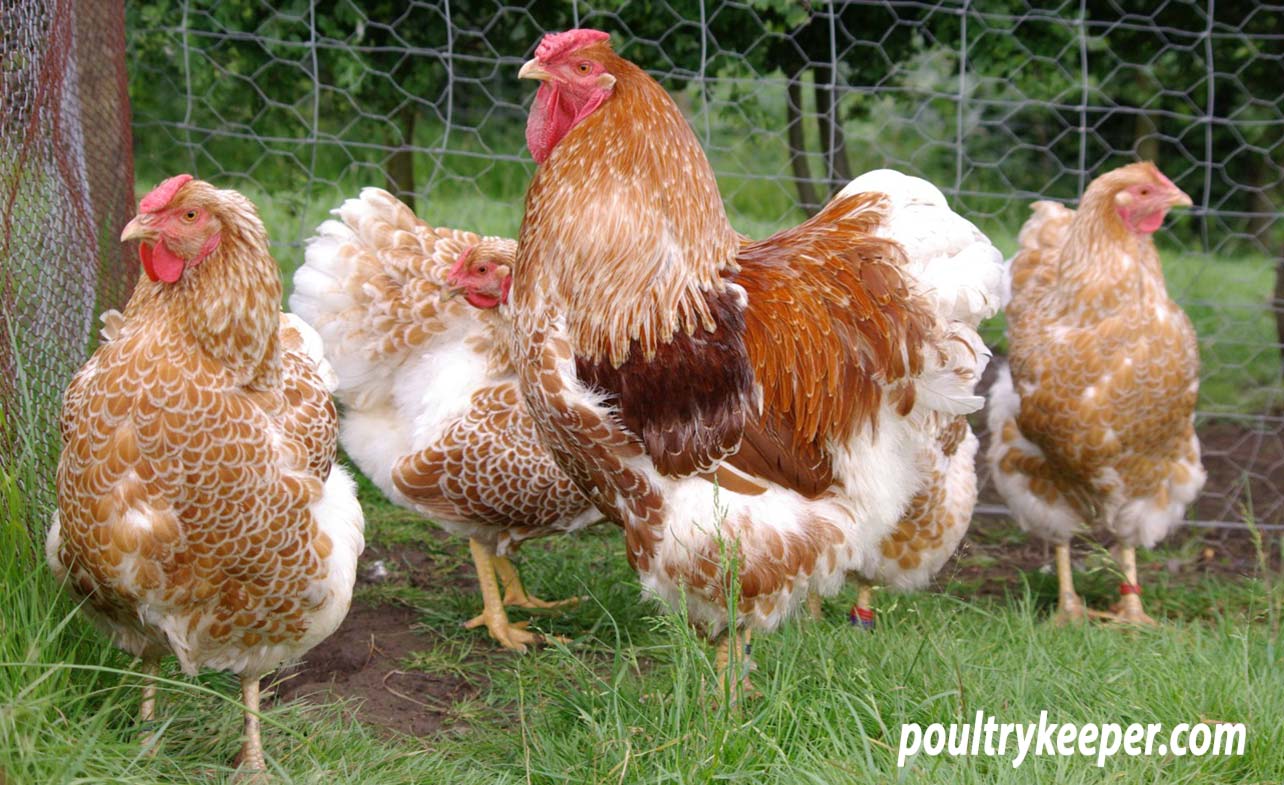
The first Buff Laced was seen in America in 1886 and are credited to a Mr Ira C. Keller of Ohio. They were made by crossing Gold Laced Wyandottes to White Wyandottes – that had emerged as sports from Silver Laced Wyandottes, which is similar to how a completely British strain was made in Cornwall in the 1970s by the late Gilbert May…
His Gold Laced cockerel had jumped a fence and got in with his White Wyandottes. The daughters from the accidental mating were rather beautiful, and Gilbert saw the potential of crossing them back to his Gold Laced, to keep the white gene but purify the lacing.
This he did very successfully and exhibited them for many years. My original large fowl Buff Laced Wyandottes came from Gilbert at the Federation show (circa 2000), transported in the luggage compartment of a large coach.
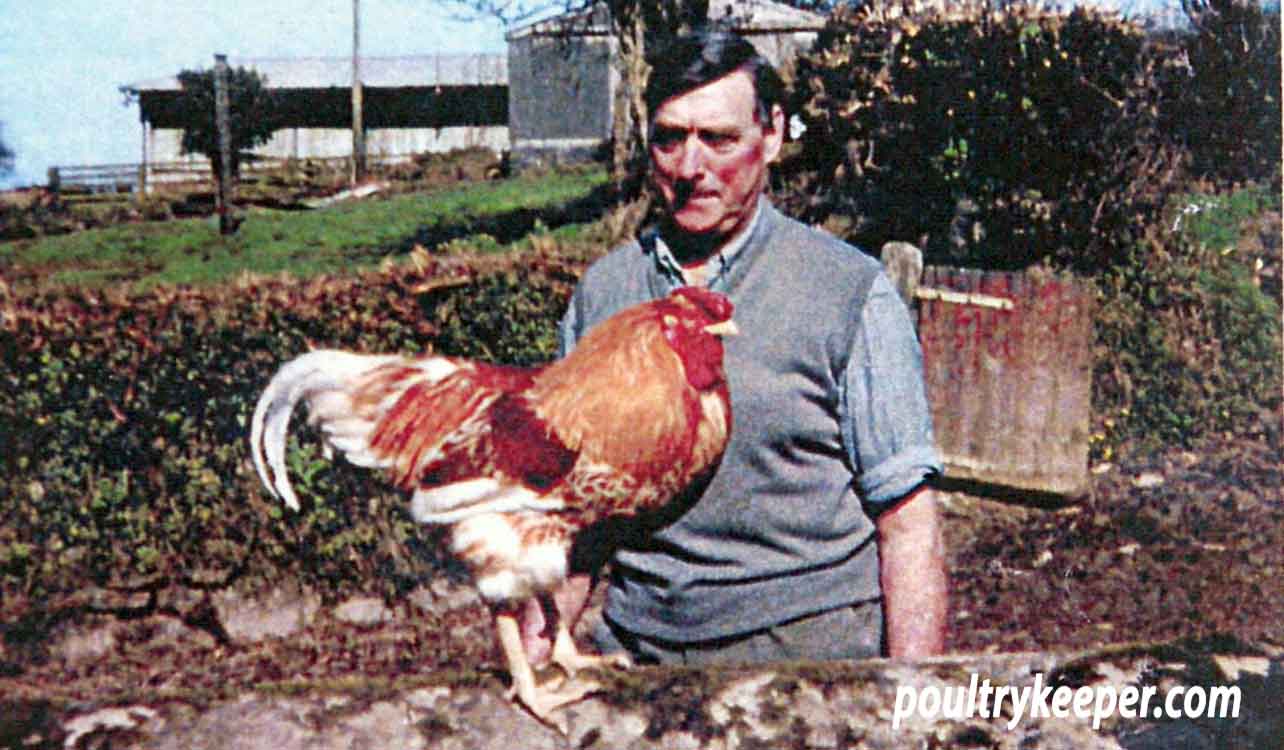
Partridge and Pencilled Wyandottes
Partridge Wyandottes are my personal favourite variety of this wonderful breed. I first saw a picture of a bantam female in the book ‘Bantams in Colour‘ which was bought for me back in 1984. It would be some years later before I saw them in the flesh – and these were large fowl at the Wernlas Collection of Rare Poultry (around 1999). I was completely captivated by the sheer beauty of the females with their black horseshoe-shapes on golden body feathers (known as concentric pencilling), whilst males, by contrast, looked very traditionally coloured.
Partridge Wyandottes were standardised in America in 1901, and the term ‘Partridge’ was likely taken from their Partridge Cochin ancestors, themselves becoming established as a colour form in the 1870s. It is believed that two main strains were created in America, the first by Mr E.O Thiem from Iowa and Mr W.A Doolittle of Kansas – known as the Western Strain. Mr Thiem first exhibited his new strain of Partridge Wyandottes at the 1894 Midcontinental show at Kansas City.
Here he learnt, to his great surprise, that George Brackenbury and Ezra Cornell, both of New York State, had been working on identical ‘Gold Pencilled Wyandottes’ – the Eastern Strain. Both strains were made of early Gold Laced Wyandottes and Partridge Cochin crosses, as well as the Eastern Strain having Dark Cornish (Indian Game) in their make up, imported from UK shores and hence why, even to this day, American Partridge Wyandottes are much darker than British versions.
It was a Mr John Wharton, of Hawes, Yorkshire, that imported some original American stock in 1896, selling his class winning cockerel at the Crystal Palace show for £100. Another British fancier, a Mr Pettipher, of Banbury, Oxfordshire, created his own British Partridge Wyandotte chickens from scratch, apparently with no American influence!
Silver Pencilled Wyandottes were created a little later and standardised in 1902. They were made by George Brackenbury and Ezra Cornell using Dark Brahmas and half-made Partridge Wyandottes.
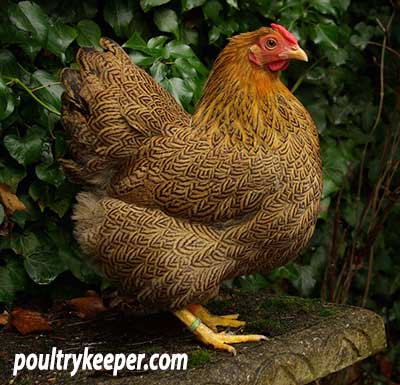
Columbian Wyandottes
The name ‘Columbian’ was bestowed on a new variety of Wyandotte, born of a chance cross of White Wyandotte and Barred Plymouth Rock, and was exhibited for the first time at the Columbian Exposition and World’s Fair in Chicago, Illinois in 1893 (a fair to celebrate the 400th anniversary of the discovery of America by Christopher Columbus).
This new creation was predominantly white across its body plumage, with a beautifully contrasting black neck and tail feathering. This attractive black neck feathering, surrounded by a very narrow white fringe to each feather, is often affectionately referred to as ‘the cape’ amongst exhibition breeders.
Recent imports of Columbian Wyandotte chickens from Bert Wagerink in the Netherlands have attracted some interest (2002, and later in 2010), but the large Columbian Wyandottes haven’t been popular on UK shores since a club existed as far back as the 1920s.
Buff Wyandottes
Buff Wyandottes were created in the US by Partridge creator Mr E.O Thiem of Iowa. They were standard by 1893 and made by crossing prototype Partridge Wyandottes with Buff Cochins, Gold Laced Wyandottes and Rhode Island Reds. They were made in the UK by John Wharton (importer of Partridge Wyandottes) by use of Buff Cochin and Silver Laced Wyandottes.
Yours truly made a strain of Buff Wyandottes in the early 2000s by crossing a Buff Plymouth Rock with a poorly marked Buff Columbian and an undersized Barred-Buff Wyandotte (from East Anglia) to Buff Orpingtons.
The progeny from both pens were then crossed, and selection took place for solid Buff plumage with yellow legs and Wyandotte shape. Some very pleasing results were attained in only 2-3 generations. Sadly, however, they never became popular (as were large Buff Orpington chickens of that time).
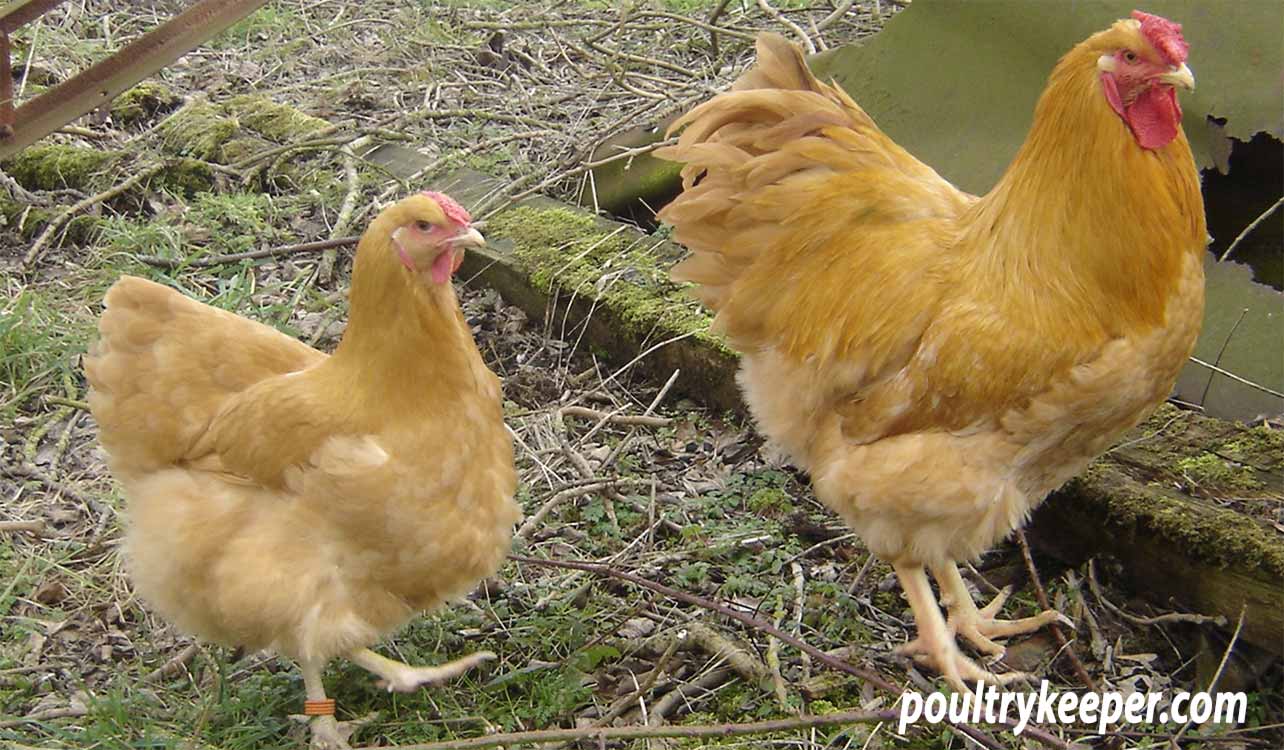
Birds of curves
The Wyandotte ‘type’ is very important to breeders… you hear them refer to it often. Wyandottes are known as ‘birds of curves.’ The rise to the tail from the end of the neck hackle/top of shoulders is quite dramatic compared to many breeds but look at the overall effect it produces.
You don’t want flat-backed Wyandottes. A good yardstick is a 35-degree rise in the back-line of the females, with more like a 45-degree rise in the males, beginning with a ‘concave sweep’ from the end of the neck hackles.
The Wyandotte should have medium length legs and wings, carried well up. Its comb should have fine workings and a leader following the line of the head. It should have a cobby appearance and be broad and deep in the body and curved when viewed from all angles – even front on.
Double mating
Really, all breeds of poultry would benefit from the applied principle of double-mating. This means that exhibition males and females cannot be produced from the same breeding pen, so you need two pens: one for exhibition males and one for exhibition females.
The need for double mating arose when breeders found it impossible to produce both male and female specimens of high standards from a single pen, especially when excellent stock was crossed together. This is because the precise plumage requirements, respectively, meant that the opposite sex equivalents of these superstar birds wouldn’t resemble their male or female (accordingly) show specimens in any way. Thus a compromise was borne – will you keep the exhibition male or female pen?
For example, suppose you breed and keep Partridge Wyandottes. In that case, you might be bowled over by the sheer beauty of the males with their black breasts, orange shoulders, biscuit-brown wing bays and lemon-edged hackle and saddle – surrounding beetle-green black centres.
Still, to breed such specimens, the females have to be very mossy and also display a lot of black in their neck hackle, surrounded by lemon edging. They are nothing like the exhibition females.
In the Wyandotte breed, a few colours must be double mated, including the Laced varieties (especially Silver Laced), Partridge and Pencilled (and their blue equivalents), and Blacks. This is why it is important to consult and join the relevant breed club and learn all about what the colour [you have chosen] requires in terms of producing correct-to-standard specimens.
If we approach the subject of breeding correctly, then double mating should be applied to all poultry breeds. It isn’t just colour that is a consideration – if we look at masculinity and femininity, for example, then it is evident in most specimens. Wyandottes, compared to breeds like Leghorns, are quite feminine in appearance – an example being the very short sickle feathers of males.
If you breed pullets, you want to use males that have short wattles and are round-feathered so far as possible. Masculine females with pointy feathers (known as cock-feathered in the fancy), as well as large combs and wattles, may be overlooked by many, but these are the details on which our past masters used to focus in fine detail and are at the heart of pure-breed poultry keeping.
These details can be the difference between first place and a best in show!
Wyandotte bantams
UK Wyandotte bantams (or miniatures, to be correct) were created initially by an accidental mating of Modern Game and Dark Brahmas, owned by a Mr J.F Entwistle. This gave him an idea for Wyandotte bantams!
He brought in undersized large fowl Partridge Wyandottes to develop his vision, and by 1902 was showing both Partridge and Silver Pencilled Wyandottes in local shows.
Whites began as sports from the Partridge, as well as Japanese and Silkie crosses, and Blacks came about through Pekins and Rosecombs, as well as other breeds crossed to prototype Wyandottes. However, even by the 1920s, most specimens were skinny and racy and didn’t really represent the Wyandotte breed.
It wasn’t until the 1970s when German breeders started miniaturising large fowl, that Wyandotte bantams began to take form. UK breeders visited German shows and imported new varieties to add to the well-established British varieties.
However, it is worth mentioning that British Partridge Wyandotte bantams proudly owe their precise patterning to the late Dr Clive Carefoot, a past president of the Poultry Club and Partridge and Pencilled Wyandotte Club. He also recreated the Silver Pencilled Wyandottes in the UK and did a lot for promoting both varieties.
These days (2021), the Partridge and Pencilled Wyandotte bantams are still popular, and mainly through the efforts of current club president Professor Geoff Parker, who has won no less than 36 breed club championships with his birds. He’s also bred thousands and given many people a start with them, but they still take some skilful breeding to get right.
White Wyandotte bantams are still popular and have a lovely docile nature – undoubtedly due to their Pekin/Cochin ancestry. The Laced varieties still have good numbers of bantams at shows, especially the Silver and Blue Laced.
Barred, Columbian, Buffs and Blues all seem to come in and out of fashion, and the recently standardised Chocolates (by Richard Davies) are rarely seen at shows as of the time of writing.
Bantam Blacks see reasonable numbers at shows, but occasionally specimens can be too feathery – with males displaying too much neck hackle (spoiling the back-line) and combs with too much work.
Large fowl
Large White Wyandottes are still fairly popular and many people have been inspired by breeders such as Allan Procter from Lancashire, who won countless awards with his strain for decades.
Large Laced colours often struggle for numbers nowadays, with very few entered at National Shows (the Blue and Buff Laced often struggle to get more than three entries per class). Large Barred Wyandottes have been AWOL for a few years at the time of writing.
Large Lavenders are now standardised (Allan Brooker), but few are seen, which is a similar situation with large Blues, although through the work of Steve and Harley Dace and Christopher Bennett, are beginning to enjoy something of a revival.
Large Buffs are being recreated and kept by a few breeders, but few are seen at the shows at present. Large Black Wyandottes have been infused with life by various outcrosses, so are productive and vigorous fowls once again, and mainly through the work of Steve and Harley Dace.
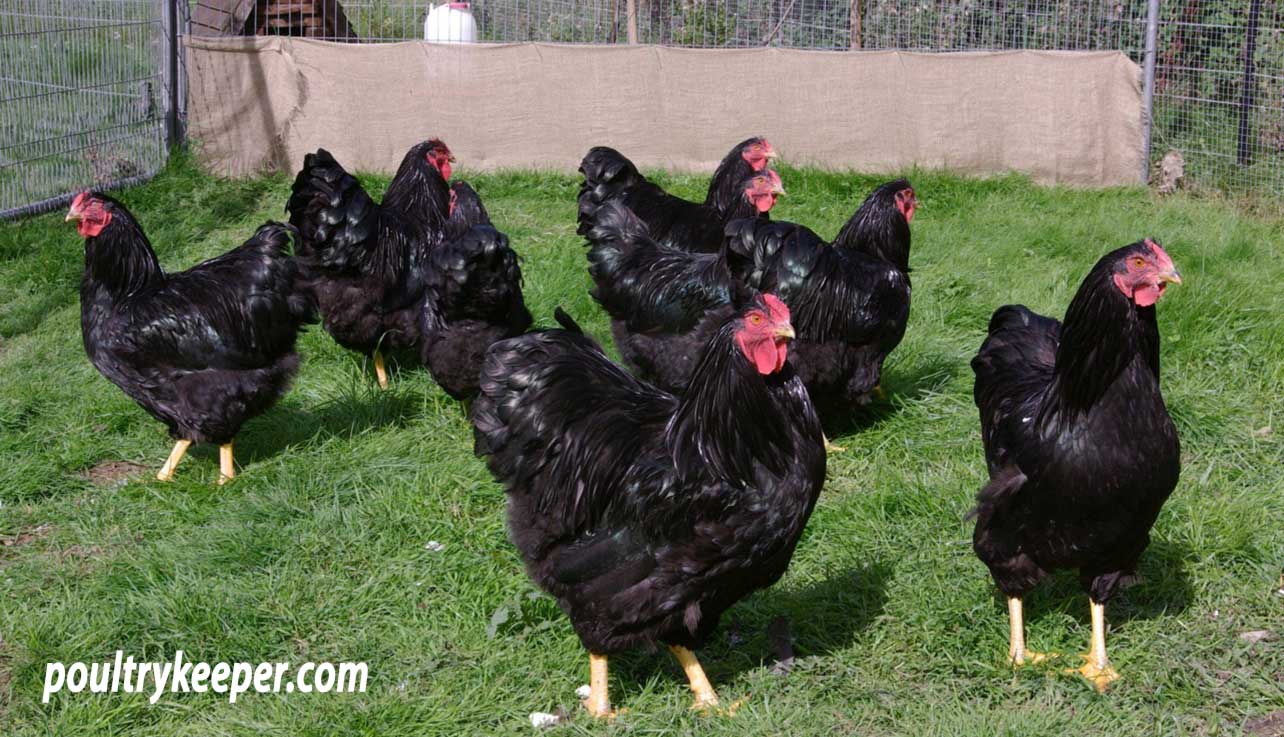
To keep
Wyandotte chickens should be calm by nature and good egg producers, though due to such mixed ancestry in their make-up, strains can vary quite a lot. Some varieties can be nervous and flighty (such as the Partridge), so handling and breeding for a calm temperament is recommended. They are a relatively low maintenance breed that will go broody if allowed to sit; the Partridge and Pencilled bantams (including Blue versions) are very broody, as are the White bantams.
Wyandotte chicken breed profile
Uses: Utility (meat) and exhibition.
Origin: America.
Eggs: 100 – 200 tinted.
Weight: Cock: 4.08 Kg Min.Hen: 3.17 Kg Min.
Bantam Cock: 1.7 Kg.Hen: 1.36 Kg.
Colours: Barred, Black, Blue, Blue Laced, Buff, Buff Laced, Columbian, Gold Laced, Partridge, Blue Partridge, Silver Pencilled, Silver Laced, Red, White (Standardised UK) Blue Laced, Cuckoo, Violet Laced, White Laced Buff (Bantam)
Useful to Know: Docile and a good choice to have around with children. Available in Bantam size.
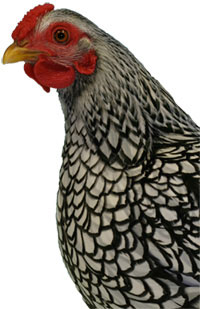
Photo Gallery
Books
The following books are available. Links take you to the Amazon or other sellers’ pages for the books.
- Popular Poultry Breeds – D. Scrivener – P.261
- Storey’s Illustrated Guide to Poultry Breeds – C. Ekarius P.103
- British Poultry Standards – P.311
- American Standard of Perfection – P.45
- 21st Century Poultry Breeding – G. Brereton (Various pages)
Breed Clubs
There have been many Wyandotte clubs over the years, but this breed still boasts the most clubs for a single breed. Today, in the UK, we have the following clubs: Partridge and Pencilled, Laced, Black, White, and finally a club just called The Wyandotte Club, which initially was The Wyandotte Bantam Club which eventually became redundant as other clubs began to cater for their respective bantams. The Wyandotte Club, in theory, caters for all the colours not covered by their club, but paradoxically to some, still offers rosettes and awards to all colours at certain shows.
Here is a complete list of clubs for Wyandotte chickens:
- UK: The Wyandotte Club: Contact Mr Jeff Maddock (Secretary) 01229 772556
- UK: Wyandotte Bantam Club: No contact information at the moment.
- UK: The Scottish Wyandotte Bantam Club: Contact Mrs Agnes Aitken (Secretary) 01569 766775
- UK: The Black Wyandotte Club: Contact Mr E G Crossland (Secretary) 01226 762443
- UK: The White Wyandotte Club: Contact Mr K Horrobin (Secretary) 01594 836212
- UK: The Laced Wyandotte Club
- UK: The Partridge and Pencilled Wyandotte Club: Contact Rhona Duncan (Secretary) red1007@hotmail.co.uk
- US: Wyandotte Bantam Club of America
- AUS: The Wyandotte Club of Australia Inc.

